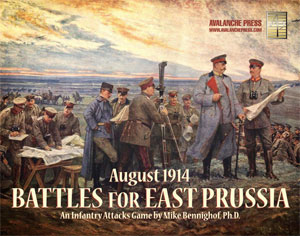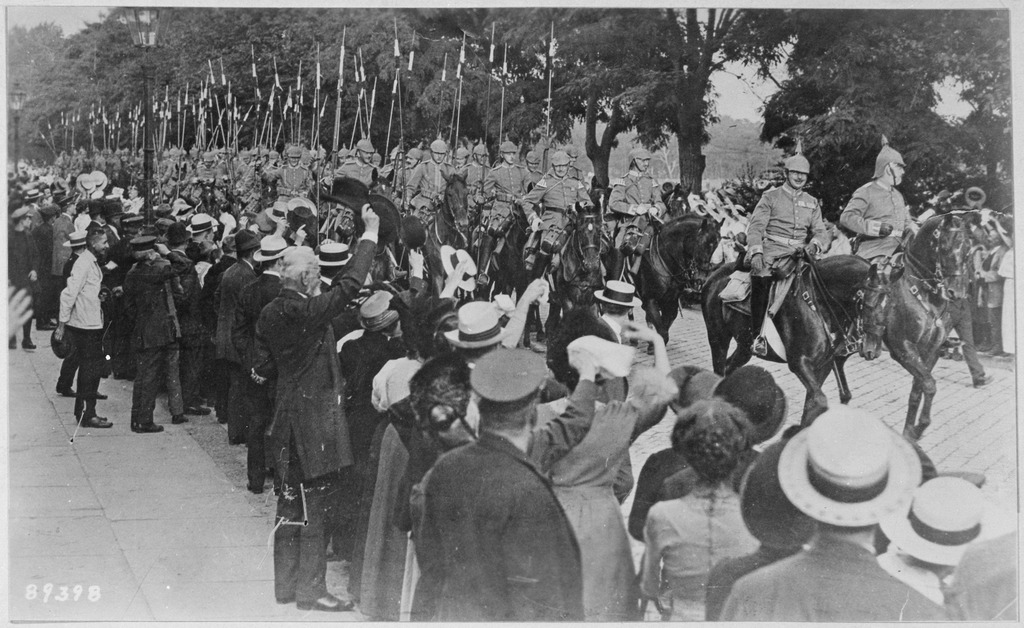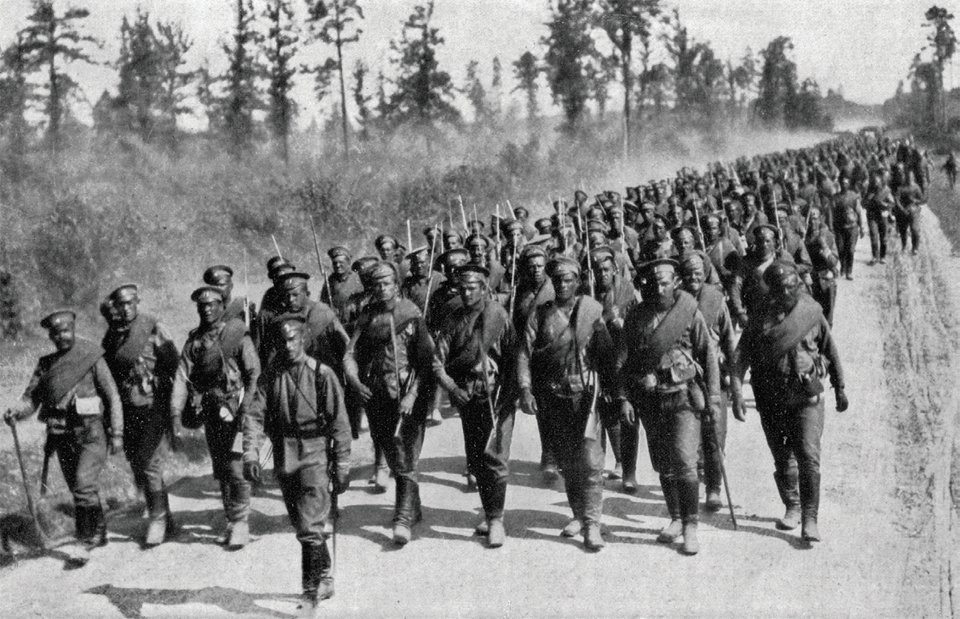| Tannenberg 1914:
Part One, War Plans
By Mike Bennighof, Ph.D.
September 2020
 While the very existence of a so-called “Schlieffen Plan” has been questioned, German plans for war in 1914 very definitely called for an offensive in the West matched by a defensive posture in the East. Seven of Imperial Germany’s eight field armies would be sent against the French (and Belgians), with just one retained in East Prussia to face the Russians. While the very existence of a so-called “Schlieffen Plan” has been questioned, German plans for war in 1914 very definitely called for an offensive in the West matched by a defensive posture in the East. Seven of Imperial Germany’s eight field armies would be sent against the French (and Belgians), with just one retained in East Prussia to face the Russians.
The Eighth Army, based on the peacetime I Army inspectorate, had three regular army corps of two divisions each, a reserve corps of two more divisions, and a third independent reserve division plus one cavalry division. East Prussia remained an agricultural province, relatively sparsely populated and unable to support such a large establishment. So most of the divisions supposedly stationed there actually drew a large proportion of their recruits and reservists from Germany’s big cities. Three Landwehr brigades initially joined the field forces, with another division arriving from northern Germany during the course of the campaign while additional Landwehr troops were at times detached from fortress garrisons for service in the field. All told that gave Eighth Army eleven and a half infantry divisions of varying quality and one cavalry division.
Command would go to Maximilian von Prittwitz, then 65 years old. Prittwitz had held the local army inspectorate command before the war. Previously he had served on the general staff and before coming to East Prussia had commanded XVI Corps in Metz, one of the premier peacetime slots for general officers as it directly faced the French border.
The Russian Army initially did not deploy its reserve formations into the field armies - mobilization took too long - and did not use its opolchenie, the Russian equivalent to the Landwehr, in the front line. The extent to which the Germans would deploy second- and even third-line troops in 1914 was not foreseen by any of their enemies.

German cavalry depart for the front, August 1914.
The invasion of East Prussia would be commanded by Gen Yakov Zhilinski of North-West Front, in peacetime the commander of the Warsaw Military District, considered the most important regional command due to the constant unrest among the Tsar’s Polish subjects. Zhilinski had been chief of the Imperial General Staff until March 1914, and in that capacity had negotiated the military agreement with Russia’s French allies that the Russians would invade East Prussia by the 15th day of mobilization.
To accomplish this, Zhilinski initially had two armies, with a third scheduled to take the field as mobilization progressed. First Army, commanded by Pavel von Rennenkampf, drew its forces from the Vilnius Military District, and initially fielded four regular army corps with eight divisions and a rifle brigade, plus five cavalry divisions and an independent cavalry brigade. An additional corps with two reserve divisions entered the line on 31 August.
Second Army’s troops came from the Warsaw Military District, though most were ethnic Russians - the Imperial Russian Army did not trust its Polish subjects and therefore did not concentrate them in military units. Alexander Samsonov’s Second Army had five regular army corps with ten divisions plus one rifle brigade. It was also assigned the Guard Corps of two divisions, which did not enter German territory. In addition, Second Army had three cavalry divisions.
The two Russian armies each sent one corps to the other’s command during the course of the campaign and those are listed with their initial army command.
Russian divisions were larger than their German counterparts (with 16 infantry battalions against 12 in the German division), but the German division had substantially stronger artillery (54 field guns and 18 howitzers, against 48 Russian field guns and no howitzers). While each Russian division had its own cavalry for scouting purposes, these were almost all Cossack sotnaya (“hundreds”), many of which had not arrived in the forward areas when the campaign began. The cavalry assigned to the corps and divisions in peacetime was for the most part pulled into the cavalry divisions upon mobilization. That meant that the Russians, despite overwhelming superiority in mounted troops, stumbled forward more or less blind. Each German regular division had its own cavalry regiment, while German civilians used the intact telephone network to call in a steady stream of reports on Russian positions and movements.
The Germans had other advantages, starting with the East Prussian railway network. It included several double-tracked lines, allowing the Germans to move their divisions rapidly and efficiently; the railway move of I Corps from its positions facing the center of the Russian First Army to the far left flank of Second Army would turn out to be the decisive maneuver of the campaign.
Along the same lines, German forces were better supplied and better fed, as they remained close to their bases while the Russians steadily moved away from theirs. The Germans fought on friendly territory and could count on the support of the local population.
Russian policy, meanwhile, had for several decades insisted on denuding the parts of Russian Poland bordering East Prussia on the south of paved roads and railroads. Russian railroads since the time of Nicholas I had used a broader gauge than those of the rest of Europe: German rails lay 1440mm apart, Russian rails 1524mm. That meant that Russian rolling stock could not roll on German rail lines.

Russian infantry mobilize, August 1914.
Second Army faced a lengthy approach march on foot just to reach the German border; Samsonov’s men, already tired, crossed into enemy territory four days after First Army had done so. First Army, chivvied forward in order to meet Zhilinski’s promise of an invasion fifteen days after mobilization began, did so lacking many essential supply services and its logistics broke down almost immediately.
German chief of staff Helmuth von Moltke (usually called “The Younger” to distinguish him from his uncle, also Helmuth von Moltke, who had led Prussian armies to victory against Austria in 1866 and France in 1870) expected Eighth Army to conduct an active defense of East Prussia. In keeping with the German Army’s Auftragstaktik (“mission tactics,” often misleadingly translated as “mission-oriented orders”), Prittwitz had the freedom to fulfill Moltke’s directive as he saw fit. Moltke ordered him to avoid getting his army destroyed in open battle, to avoid begin shut up in the fortress lines of Königsberg, and to draw as many Russians as possible away from the front in Galicia facing the Austrians. If he could not hold back the Russians within these orders, he was authorized to pull out of East Prussia to make a stand along the Vistula, but Moltke made clear that this would be regarded as a disaster.
Moltke had laid down a seemingly impossible set of requirements. Eighth Army had to defeat the Russians, or at least keep them occupied, without being wiped out itself. And it had to do so while outnumbered by better than two to one, with the Russians already having East Prussia mostly surrounded. Prittwitz and his chief of staff, Georg von Waldersee, did make an early decision that would help lead to victory at Tannenberg. Rather than seek out the Russians for battle, they ordered their corps to hold in place and await news of Russian movements. With almost half of their force made up of reservists and militiamen, most of them out of shape when they reported for duty, they could not afford to exhaust their infantry with marches and counter-marches before the first Russian had even been spotted.
Having given his personal word to the French, Zhilinski intended to strike as quickly as possible, bringing First Army directly from the east into German territory while Second Army struck from the south. The initial plan called for both armies to maintain their concentration, but as it began to appear that First Army was having success Zhilinski steadily broadened the front assigned to Second Army. Not only would Samsonov have to send troops to the north-east to support Rennenkampf by striking the Germans from the rear, he would also have to send several corps north-west to cut off the Germans from their lines of retreat. That would prove a fatal error, as the Germans would exploit the gaps between Second Army’s corps to destroy them in detail.
You can order August 1914 right here.
Please allow an extra three weeks for delivery.
Sign up for our newsletter right here. Your info will never be sold or transferred; we'll just use it to update you on new games and new offers.
Mike Bennighof is president of Avalanche Press and holds a doctorate in history from Emory University. A Fulbright Scholar and NASA Journalist in Space finalist, he has published eleventy-million books, games and articles on historical subjects.
He lives in Birmingham, Alabama with his wife, three children and his dog, Leopold.
|
